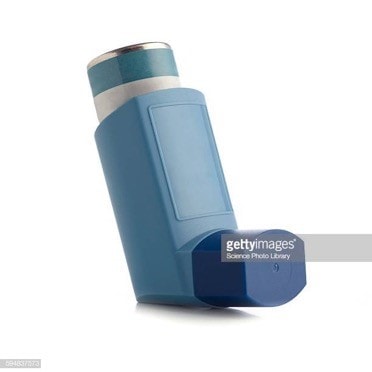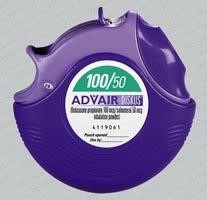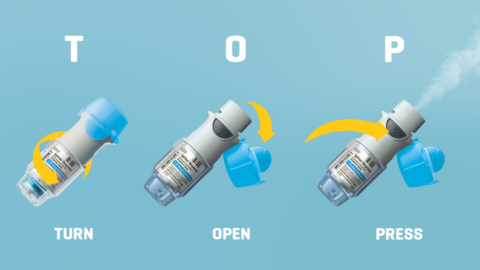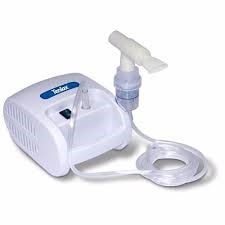Do You Use Your Inhaler Correctly?

Fall is one of my favorite times of the year. Not only do we get to feel the cooler weather and drink our favorite fall flavored lattes, but it also happens to be a time of respiratory recognition. October hosts Respiratory Care week and November is Chronic Obstructive Pulmonary Disease (COPD) awareness month. COPD is a narrowing of the pulmonary airways, most commonly caused by long-time smoking.
In my 12 years as a respiratory therapist, I have heard many times, “I don’t think my inhalers are working.” My response always is, “Can you show me how you are taking your inhalers?” Often times what I see is that these inhalers are not taken the correct way.
There are four different types of inhalers that can be prescribed:
- Meter Dose Inhalers (MDI) – Medication given through a pressurized canister, contained in a plastic holder with a mouth piece.
- Dry Powder Inhalers (DPI) – Inhaled medication, in the form of a dry powder.
- Respimat Inhalers – Inhaled medication, in the form of a fine mist that is inhaled through a mouth piece.
- Nebulizers – A machine that delivers liquid medication as a fine mist by using compressed air.
If you feel that your respiratory medications are not working correctly, it may be you are not using it properly and that little or no medication is reaching your lungs. Each inhaler needs to be inhaled in a very specific way. Let’s first go through how each of these inhalers should be inhaled.
Metered Dose Inhaler (MDI)
 If you have an MDI, I challenge you to spray one dose in the air and see how far the medication travels. In my experience, this medication will project 12-16 inches. If you take your MDI by placing it directly in your mouth, a majority of this medication is getting deposited in the back of your throat, not into your lungs. The medication can only be effective if it is inhaled into your bronchiole airways.
If you have an MDI, I challenge you to spray one dose in the air and see how far the medication travels. In my experience, this medication will project 12-16 inches. If you take your MDI by placing it directly in your mouth, a majority of this medication is getting deposited in the back of your throat, not into your lungs. The medication can only be effective if it is inhaled into your bronchiole airways.
The first key to taking an MDI, is making sure you are using it with a spacer. A spacer is a device that you place your inhaler into. Spacers give your medication a contained space for the medication to go into so that you can get a full dose of medication. You may lose 80%-85% of your medication if you do not use a spacer[1].
 The second key to maximize the benefit of MDI’s is using it correctly. To take your MDI correctly, follow these steps.
The second key to maximize the benefit of MDI’s is using it correctly. To take your MDI correctly, follow these steps.
- Remove cap and shake canister well.
- Exhale completely.
- Place the spacer or inhaler in your mouth.
- Breathe in slowly and completely through your mouth.
- Hold your breath for 5-10 seconds.
- If you are prescribed more than 1 puff, wait 1 minute in between puffs.
Reminder: If you are taking an inhaled steroid, rinse your mouth after using the inhaler.
Dry Powder Inhaler (DPI)

Dry Powder Inhalers (DPI), are taken a bit differently that MDIs. DPIs do not have the pressurized container to propel the medication out of the canister. With DPIs, you must create enough force with your breath to inhale the medication into your lungs. With MDIs (first example) the breath should be taken in slowly, as opposed to DPIs where the breath should be taken in quickly and forcefully.
To use your DPI properly, follow these steps.
- Remove cap.
- Add or load mediation dose.
- Exhale completely.
- Place the inhaler in your mouth.
- Breathe in quickly and deeply through your mouth.
- Hold your breath for 5-10 seconds.
- If you are prescribed more than 1 puff, wait 1 minute in between puffs.
Reminder: If you are taking an inhaled steroid, rinse your mouth after using the inhaler.
Respimat Inhalers

Respimat inhalers are a great alternative to DPIs and MDIs but may be more costly depending on your prescription and insurance carrier. Respimats are pressurized like MDIs. This means that the medication can be projected into the lungs. The particle size is very small so it can be inhaled easily. For the best effectiveness, use your respimat inhaler with a spacer as well. To use your respimat inhaler correctly, use the following steps:
- Hold the inhaler upright with the cap closed.
- Turn the clear base a half turn in the direction of arrows until you hear a click.
- Flip the cap open.
- Exhale completely.
- Wrap your lips around the mouthpiece without covering the air vents.
- Press the dose release button and continue to breathe in slowly.
- Hold your breath for 5-10 seconds
- Exhale through pursed lips.
- Close the cap.
- If another dose is required, repeat these steps.
Reminder: If you are taking an inhaled steroid, rinse your mouth after using the inhaler.
Nebulizers
 Nebulizers are a great source for inhalation of respiratory medications. The medication is inhaled over a 10-15 minute period. With a nebulizer you simply perform normal breathing, through a mouth piece or mask, and you get your full dose of medication. Nebulizers can be used on a daily basis, or can be kept for times when your breathing feels especially difficult. To use your nebulizer follow these steps:
Nebulizers are a great source for inhalation of respiratory medications. The medication is inhaled over a 10-15 minute period. With a nebulizer you simply perform normal breathing, through a mouth piece or mask, and you get your full dose of medication. Nebulizers can be used on a daily basis, or can be kept for times when your breathing feels especially difficult. To use your nebulizer follow these steps:
- Wash your hands.
- Place your nebulizer on a flat, dry surface.
- Ensure that your nebulizer is plugged in.
- Connect one end of you tubing to your compressor and the other end to your nebulizer.
- Attach the mouth piece to your nebulizer.
- Measure medication and place it into your nebulizer cup.
- Place the mouthpiece in between your teeth with your lips tightly sealed.
- Turn on your nebulizer.
- While keeping your head straight, breathe medication in through your mouth.
- Your nebulizer treatment is finished when there is no more mist being produced or you start to hear it to sputter.
Reminder: If you are taking an inhaled steroid, rinse your mouth after using the inhaler.
If you think your inhalers are not working, you first want to make sure that you have a spacer, especially if you have an MDI inhaler. Follow the steps for your specific type of inhaler to ensure that you are using the inhaler correctly. While there are some respiratory medications that can be taken “as needed,” if you are prescribed these medications on a daily basis, you must use them every day. If you are not sure if you are prescribed a daily inhaler or “as needed,” contact your healthcare provider for clarification.
If you have an MDI and are having difficulty pressing the canister and taking the breath at the same time, or if you are having a difficult time pushing the canister due to arthritis, ask your doctor if they think you would benefit from switching your medications to a nebulizer.
Smoking is the biggest risk factor in being diagnosed with COPD. If you have a long smoking history, and you have never had a pulmonary function test before, it may be a good time to talk to your doctor about getting assessed for COPD. A pulmonary function test is a great tool for helping with this assessment. Island Health has a pulmonary function laboratory that can administer this test.
If you have already been diagnosed with COPD and continue to have symptoms of shortness of breath, taking your medications correctly can be a big help. Island Health also offers pulmonary rehabilitation, which help reduce symptoms of shortness of breath through exercise and education. If you have any questions about pulmonary rehabilitation or pulmonary function test, feel free to call our Respiratory Therapy department at 360.299.1363.
I hope these small tips help you get the most out of your respiratory medications.
Island Health also offers a low-cost online class: Living Well with COPD which discusses how COPD affects the pulmonary arteries and other organs, diagnosing, and common treatments of COPD, strategies to make living with COPD and daily tasks easier, as well as breathing techniques and proper use of medications. For more information and to register for the class, click here or call 360.299.4204.
Island Pulmonology is Island Health’s newest specialty clinic. They offer comprehensive care for lung and respiratory system diseases and disorders. Our goal is to help you have the best quality of life by helping you manage and treat your symptoms. Island Pulmonology’s physicians are now accepting referrals from primary care and other specialties. Patients may also call directly to request an appointment in Anacortes by calling 360.299.4273.
[1] Using your metered dose inhaler (MDI). American Thoracic Society. Available at: https://www.thoracic.org/patients/patient-resources/resources/metered-dose-inhaler-mdi.pdf. Accessed May 13, 2020.
